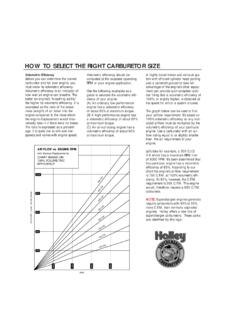Transcription of Krashen’s Five Proposals on Language Learning: Are ... - ed
1 English Language Teaching; Vol. 6, No. 1; 2013 ISSN 1916-4742 E-ISSN 1916-4750 Published by Canadian Center of Science and Education 128 Krashen s five Proposals on Language Learning: Are They Valid in Libyan EFL Classes Ibrahim Abukhattala1 1 The Libyan Academy, Misurata, Libya Correspondence: Ibrahim Abukhattala, The Libyan Academy, Miusrata, Libya, 177. Tel: 218-91-322-4987. E-mail: Received: October 18, 2012 Accepted: November 7, 2012 Online Published: December 12, 2012 URL: Abstract The most remarkable theory which aims to offer an overall explanation for SLA is Krashen s Monitor Theory.
2 As documented by the professional literature, although it has received a great deal of criticism, this theory has had a great influence on all aspect of second Language research and teaching since the 1980s. Krashen s theory seems to be attractive to many Language teachers all over the world. Based on my experience as an EFL teacher and researcher, I attempt to provide a critical analysis of the theory s five main hypotheses and the applicability of these Proposals in foreign Language contexts. Keywords: Language acquisition, Language learning, Monitor theory, Stephen Krashen, EFL classes, EFL methodology 1.
3 Introduction Unlike some earlier theories about Language learning, Krashen s theory on second Language acquisition (SLA) has been stated in simple Language - in words the majority of teachers can understand, and uses examples from classroom practice. However, this theory must be adapted according to the different situations in which students experience Language acquisition. Before analyzing what I believe is a useful adaptation of Krashen s theory, I will briefly review his hypothesis. 2. Krashen s five Proposals Learning/Acquisition Distinction Hypothesis According to Krashen and other SLA specialists (Krashen and Terrell 1983; Littlewood, 1984; Ellis, 1985), students have two different ways of developing skills in a second Language : learning and acquisition.
4 Learning is a conscious process that focuses the students attention on the form of the Language (structure). Acquisition, unlike learning, is a process similar to that by which we acquired our mother tongue, and which represents the subconscious activity by which we internalize the new Language , putting emphasis on the message (meaning) rather than on the form. Acquisition is, thus, the untutored or naturalistic way. In most classrooms learning is emphasized more than acquisition. In traditional classrooms one of the first things teachers say pay attention , and they have students analyze, and take notes on, the new structure item in the lesson.
5 Later, students are given practice in providing correct answers either structurally or functionally, but always remaining conscious of what they want to say. In more conservative classes they are evaluated on their grammatical and lexical knowledge; consequently, they are forced to study for the exams. However, in real life, when we interact with speakers of our own Language , we rarely focus our attention on the form of the Language the speaker use. We are concerned, rather, with what the speaker means or with the paralinguistic features of his speech ( , gestures, signs, etc.)
6 , which determine the quality of the message. We have, for the most part, been teaching grammar rules or rules of usage instead of facilitating acquisition of English in the classrooms; consequently, it is necessary to change the type of activities we perform in class in order to help students develop an accurate, automatic, and long-lasting second Language . Communicative Language teaching has improved the kinds of techniques teachers use in class. However, we must be aware of pseudo-communicative materials-texts that teach Language functions by using audio-lingual techniques.
7 For example: English Language Teaching Vol. 6, No. 1; 2013 129 Talking about occupations: S1: what do you do S2: I am a doctor (picture of a dentist) S2: What do you do? S3: I am a dentist (Picture of a lawyer) S3: what do you do? S4: I am a lawyer Acquisition techniques are, at least at present, more difficult to devise than learning techniques, but in the long run they are more effective. Table 1.
8 Learning/Acquisition Differences Learning Acquisition Conscious process Subconscious process Knowing the rules Picking up the learning Results in accuracy Results in accuracy and fluency Formal, traditional teaching helps Formal, traditional teaching does not helps Available for correction Available for Automatic production The Natural Order Hypothesis According to the Natural Order Hypothesis, learners of a second Language acquire structural items in a predictable order regardless of the order of presentation. This means that some structures are more easily acquired than others, and the order of difficulty does not necessarily correspond with what we believe in an easy or difficult structure.
9 For instance, one of the structural items that we teach first in most Language programs is the third-person singular of the simple present tense. Surprisingly, this is one of the structures acquired last. This is why we often complain of having intermediate, or even advanced, students who make mistakes with such a simple pattern. The Natural Order Hypothesis also accounts for students mistakes and errors: Students make mistakes (or developmental errors) when the structure used has not been completely acquired. However, students can use their learned competence to modify their production, thus correcting mistakes as they appear in their statements.
10 We can assume, then, that mistakes will always be present during the acquisition process, especially when dealing with the late structure. Consequently, the best way to correct students mistakes is to provide more input containing the structure in question. We must, then, take into consideration that we do not need to change the order of presentation of Language items. In fact, Krashen suggests that we present the Language without any conscious effort to organize it; on the contrary, he recommends a syllabus based on topics, functions, and situations.












